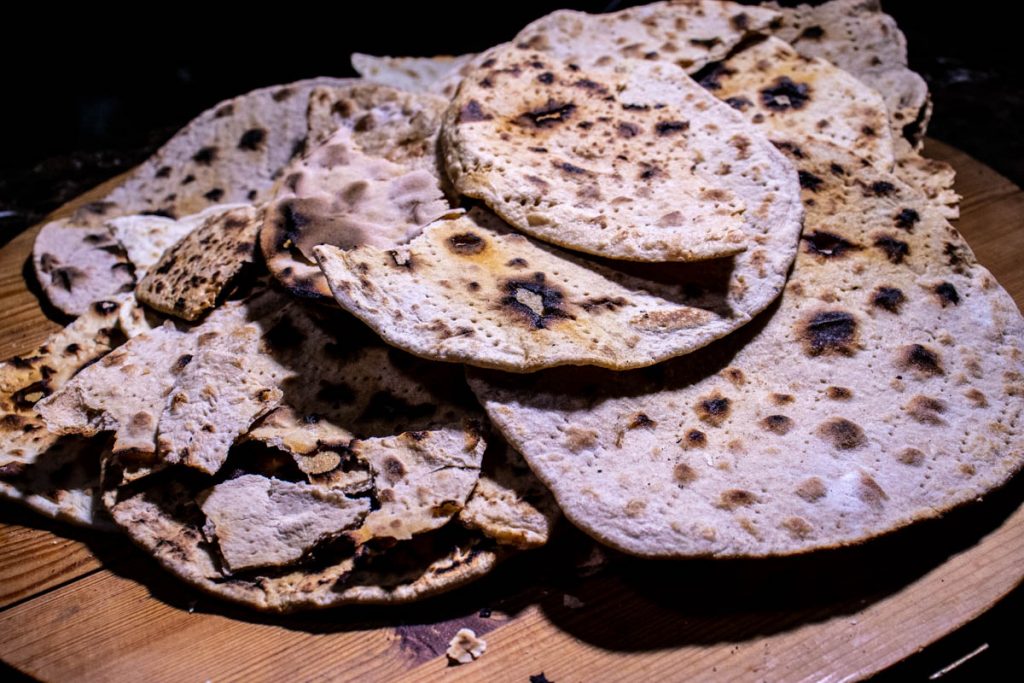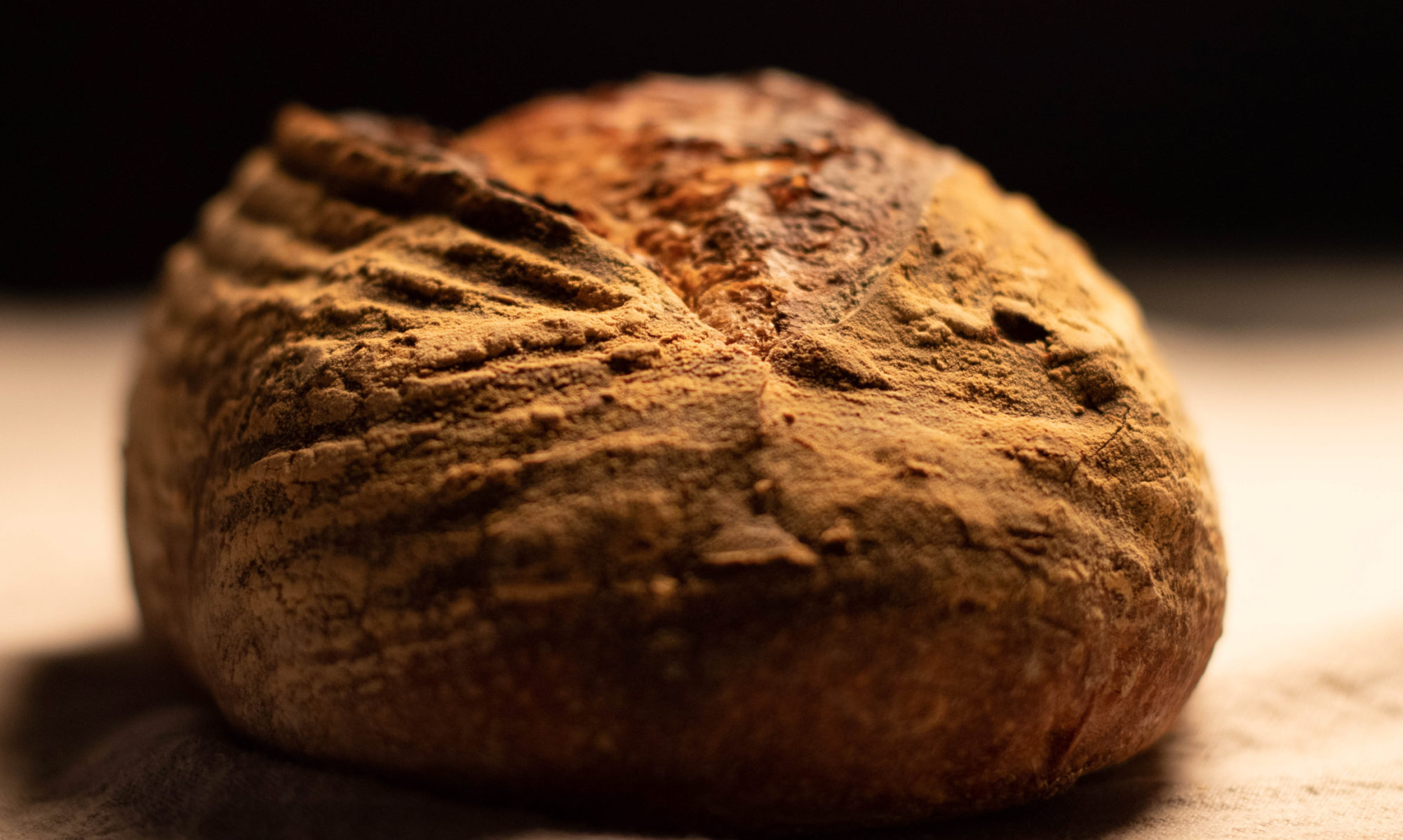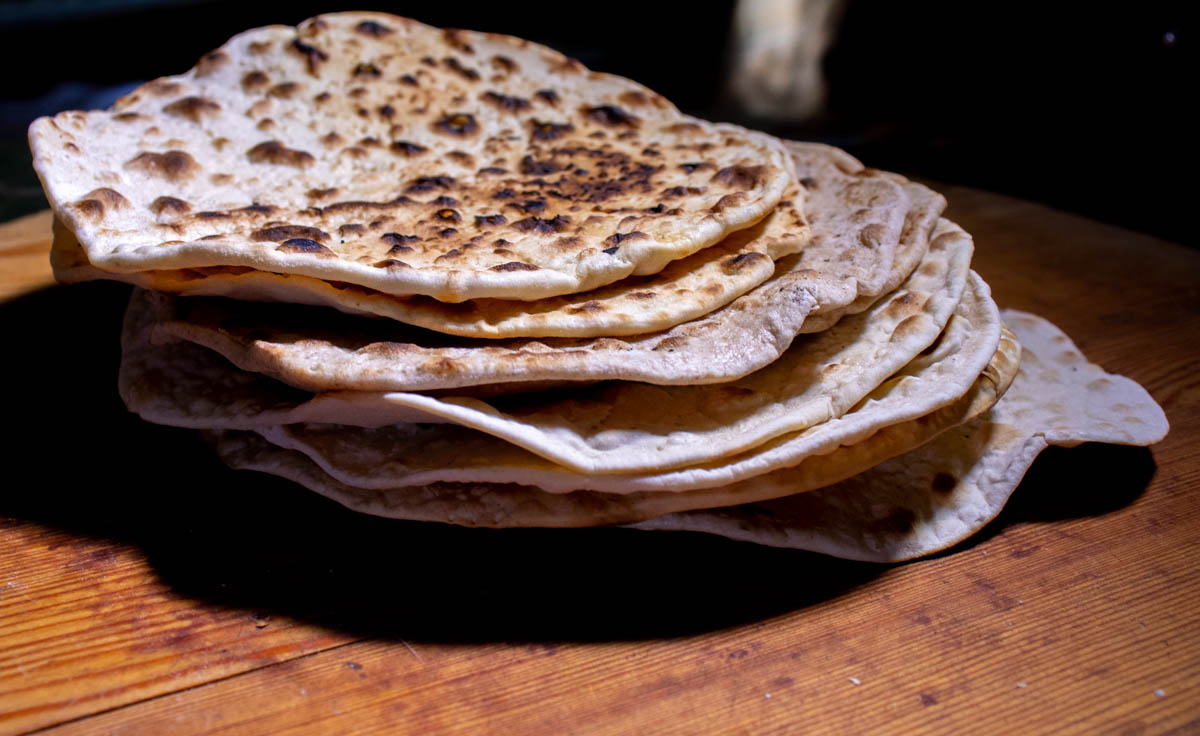The sourdough backlash has begun. Countless people who began their quarantine by making a starter and delving into the world of bread baking are now turning their backs on their starters, tired of the daily chore of feeding and caring for their new pet. With yeast hard to find, this is a good time to delve into the world of unleavened bead.
…which works out well for me as I had been planning on doing some matzah recipe testing after Passover anyway.
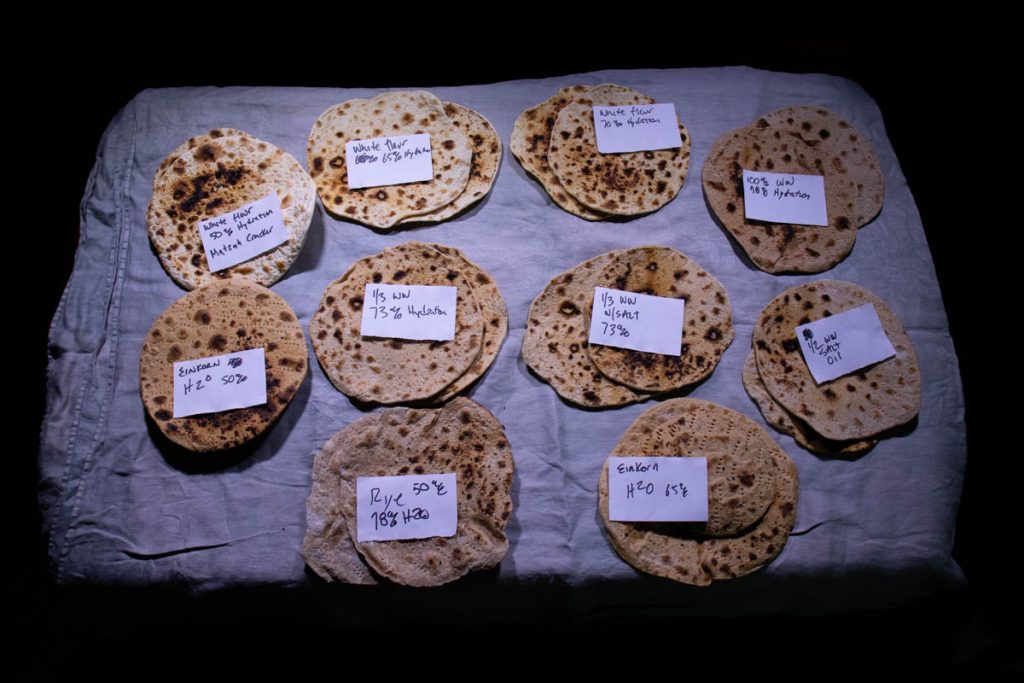
Thinking Outside The Box
This whole matzah baking enterprise resulted in a real change in my thinking about matzah. I grew up in a square-matzah world. Until about 15 years ago, I didn’t know there was any matzah other than the flat, dry, square, white kind that came in a box and never goes stale. Fifteen years ago I was introduced to the big, round, hand-made, whole wheat “shmurah matzah” that many communities use at passover. This was a matzah revelation, one that has been sustaining us at Passover ever since.
Now don’t get me wrong, I love the square, cracker-like matzah, and we eat a lot of it throughout the year. But not knowing that any other kind of matzah existed was like loving bread, but thinking that white loaf bread was the only kind of bread that exists.
As it turns out, that hard, square, machine-made matzah that I grew up with is only a couple of hundred years old. (The actual matzah I ate wasn’t a couple of hundred years old, just the process). Because it’s cheaper to make and incredibly shelf-stable, it quickly replaced hand-made matzah throughout much of the Jewish world. The now obvious truth, that was a shocker to me, is that for most of history matzah was soft and bread-like, rather than hard and cracker-like. In fact, there are many communities that still eat soft matzah for Passover.
Why then, I ask myself, am I only eating the hard cracker-like matzah when I could be eating delicious soft-matzah?
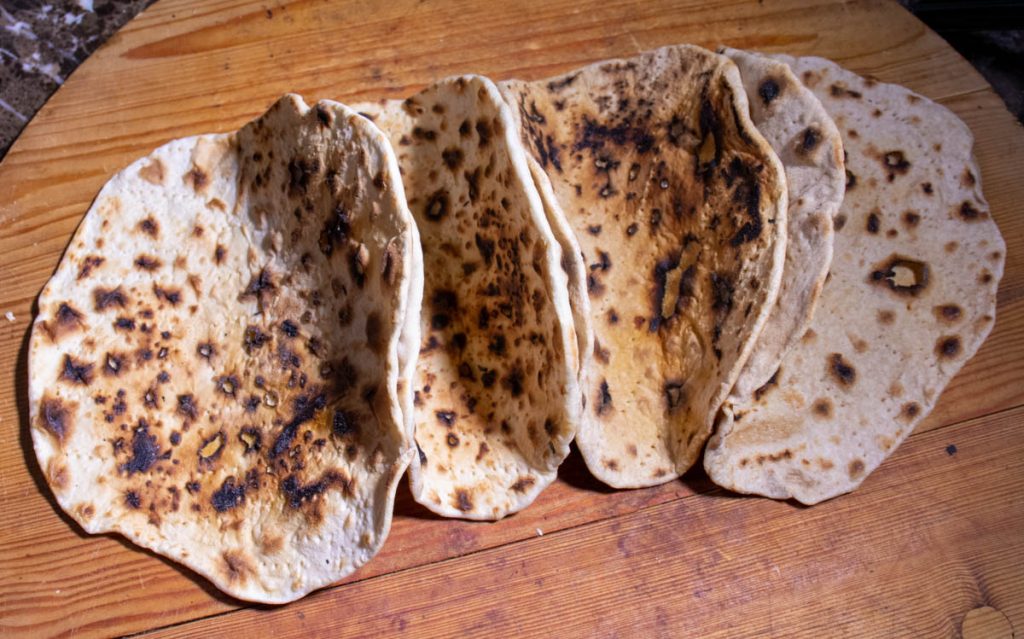
A word of caution, if you care about Jewish Law
There are lots of reasons NOT to make your own matzah for Passover. As this is a bread blog and not a blog about Jewish law, I’m not going to go into it. I will simply say, if you think you might want to make your own matzah for Passover, please check with your Rabbi before you do it.
You Learn Something New Every Day
Making my own matzah was eye opening. It turns out that baking a simple flatbread is a great way to see some basic things about bread baking without quickly and simply. What difference does a change in the formula make, both in terms of the workability of the dough, and of the final product? For example, how is a 50% hydration dough different from a 90% hydration dough? What happens when you add oil or other fats to dough? How do you do the basic math to create or change a recipe? It doesn’t tell you everything about how those same changes will impact a sourdough or other leavened loaf, but for new bakers it’s a great way to start having the conversation. Even for experienced bakers it’s an interesting way to look at simple things like hydration and salt in a very pure way.
From now on, the first bread I bake with students new to baking is going to be matzah, or some other basic, unleavened flatbread.
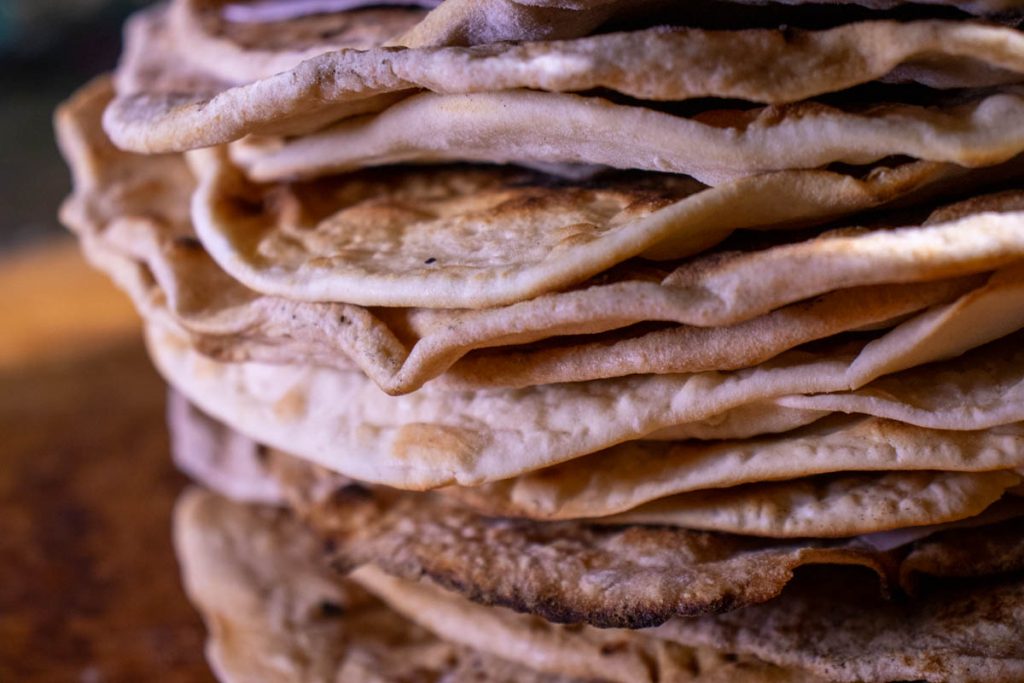
Building a Recipe
Originally I planned to find a couple of recipes, test them out, and then use the best of them. As I perused my baking books and the internet I realized that matzah recipes are all over the map. Recipes for both crisp and soft matzah had ratios everywhere from twice as much flour to water, to five times as much flour to water. Not much help. The two cookbooks I trust the most – Claudia Roden’s Book of Jewish Food and Jessamyn Waldman Rodriguez’s The Hot Bread Kitchen – had recipes that were so wildly different that I decided to just create my own recipe from scratch a la Cooks Illustrated.
I decided to start with a basic concept of what is the essence of matzah. Then I’d choose a starting place based on all of the recipes that I had read, and what I know as a baker, and I’d work from there to try to make my best matzah. Because I’d never actually baked matzah before, my idea of what I was going for changed while I was working through the process. By the time I was done I had made 10 different versions of matzah. (Eleven, actually, but one was so bad I don’t want to talk about it). There were definitely winners and losers (aren’t there always), but I feel like I now have some good matzah recipes to make throughout the year, and at Passover, if I’m brave enough.
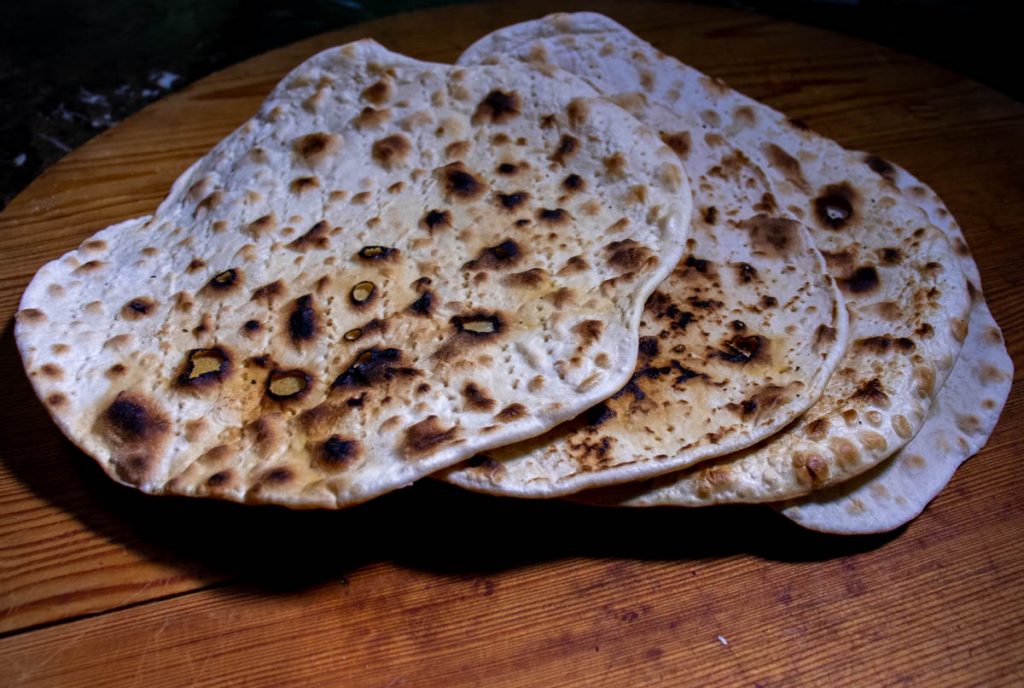
What Makes Matzah, Matzah
Matzah exists on two planes, the technical and the aesthetic. Technically, for a flatbread to be matzah it needs to be completely unleavened. If I had to guess, I would say that what this originally meant was that you they didn’t add sourdough – which was what they used to make bread rise before commercial yeast existed. However, according to Jewish Law, the way we determine if matzah is completely unleavened these days is that it needs to take less than 18 minutes from the moment that the water touches the flour until the bread is in the oven.
The aesthetics of matzah are another story. Like most other things, I’m sure each person has their own vision of the perfect matzah. For my taste, matzah should be simple. For Passover it’s just flour and water, and for the rest of the year I’ll add a little salt, and that’s it.
Whatever you may be eating on your matzah, the matzah itself carries a deep cultural flavor that needs to come through. It is the bread of freedom – that the Jewish people ate in the wilderness when we were liberated from slavery. And it is also the bread of slavery and affliction that we ate when we were enslaved. It is the afikomen – the broken and hidden piece of matzah – that many of us searched the house for at the end of the Seder when we were kids. It is the memory of every seder we’ve ever been to, and all of the family that were there with us, and all of our ancestors at their Seders. It holds the flavor of the joys and trials of the Jewish people throughout history. In order to hold that history, it needs to be simple and pure.
So, that’s my goal. To make a simple, unassuming, unleavened flatbread, that you can make from water to oven in less than 18 minutes.
To find my matzah I tried different hydration levels (the amount of water relative to flour), and different flours and flour mixtures, and with and without salt. Some recipes I looked at added a little bit of oil, which I have to say made for a slightly more complex taste, and a slightly softer and more flexible matzah. Those are usually things I like in my bread, but for matzah I decided to stick to the simple and pure which was closer to my vision of what matzah should be.
There wasn’t just one matzah recipe that I liked. As it turns out, I like matzah both cracker-crisp, and soft and flexible, and made with different flours. Following are several recipes for different matzah that I really liked.
One of the things I really liked about this dough is that it’s very flexible and quite easy to make adjustments to. So, I highly recommend that you give yourself the freedom to play with these recipes to find the matzah that is both delicious to you, and that, perhaps, connects you to your past.
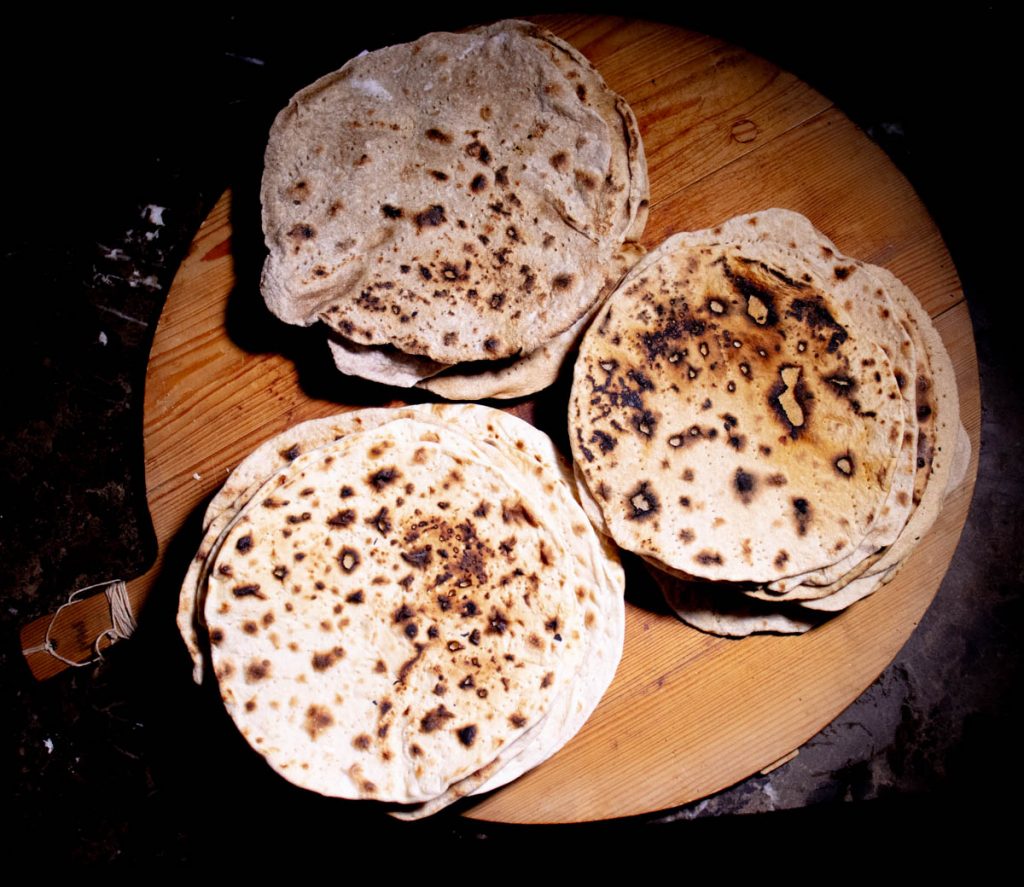
A Note on Baking Matzah
Most of the recipes that I looked at had you bake matzah in a hot oven on a pizza stone or pre-heated sheet pan. I decided instead to use a cast iron pan on the stovetop.
My reasoning for this was culinary, historical and practical.
The main reason I decided to cook on the stove-top was that my vision for matzah, especially the soft matzah, is like that of other tribal breads that are baked in a tandoor, or on a saj, or just on a hot piece of metal over a fire. Cooking it this way allowed the bread to remain soft and supple, while also having crispy burnt spots.
That being said, if what you’re after is a crisp cracker-like matzah, baking it in an oven will dry it out more and may give you more of that crispy crunch you’re after.
This was the bread that the Jewish People at while they were fleeing Egypt. It seems unlikely that they were fleeing with huge bread ovens. More likely, they baked their matzah on metal or stones that were heated over fire, as is still the practice for many cultures, especially cultures with a nomadic history (or present).
Finally, if you are going to bake matzah for Passover, you will need to have whatever you cook your Passover matzah on be set aside just for making Passover matzah. This is much easier to do with an 8″ cast iron pan than it is with a whole bread oven (though people do have ovens that they keep separate just for passover).
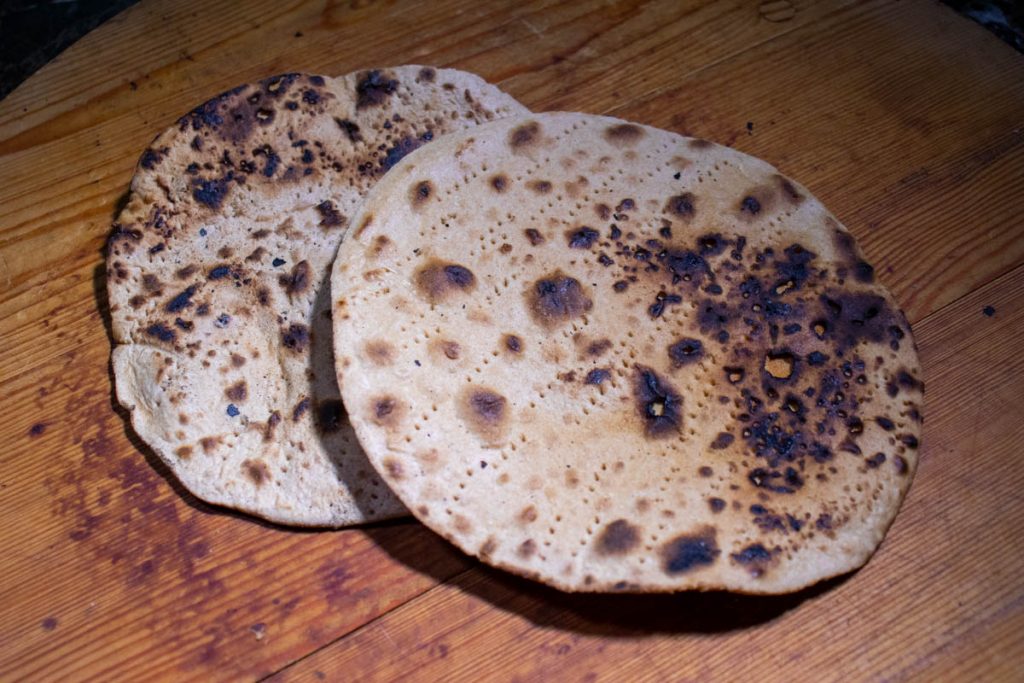
The Recipes
Let’s start with the instructions, which are the same for each of the matzah formulas.
- Preheat your cast iron pan. I used a Lodge 8″ skillet. Preheat it for at least 10 minutes to make sure it’s nice and hot. The place that I did this recipe testing has a pretty weak stove, so I pre-heated it to high. If you find that your matzah is burning more than you like before it’s cooked, try lowering the temperature of the pan. If you are going to bake these in the oven, pre-heat to 500 degrees with either a pizza stone, or a sheet pan in the oven.
- Measure out your ingredients. dry ingredients in one bowl, water (and oil if you’re using it) in another cup or bowl. Because you are going to be on the clock (remember, these need to be done in 18 minutes), you really need to have everything ready to go before you start.
- Start your timer. If you care about making these in 18 minutes, start your timer just before mixing the water with the flour.
- Pour the water into the flour and knead quickly until you have a uniform ball of dough, maybe two or three minutes.
- Separate the dough into 100g pieces and roll into balls, which should be three per recipe. The balls are about the size of an egg.
- Flatten one of the balls with your hand on a well floured surface. Then, using a rolling pin, roll out to a 2mm thick round. (A little thicker than a penny). While rolling out the dough, lift it from time to time and make sure that it’s well floured so that it doesn’t stick to the counter. If you prefer, you can also roll out onto a sheet of parchment which may make it easier to move to the pan or oven. It’s a lot like rolling out pie dough.
- Prick all over with a fork. This is to make sure that the steam that is created when it starts to cook is released to it doesn’t puff up, which is the antithesis of matzah.
- Lift the first piece off the cutting board into the pre-heated, unoiled, pan, making sure that it is flat in the bottom of the pan. I just picked up the pieces of dough with my hands, but you could also lay it over the rolling pin like pie dough, or roll it out onto parchment and then flip it over onto the pan.
- Bake on each side until it is browned the way you like it, with dark burn spots, about 2 minutes on a side. If you are trying for a more cracker like matzah, you may want to bake at a slightly lower temperature for a little longer to dry it out a little more. Or, perhaps, you can just put it in a warm oven after it’s cooked to dry it out a bit more if that’s what you’re going for.
- Remove from the pan and place between two dish-towels (or one folded over dishtowel) for soft matzah, or place on a cooling rack for matzah crackers. The towel keeps the matzah from drying out as much as it cools, which is what you want for soft matzah.
- While the first one is baking, roll out the other balls so they are ready to pop into the pan as soon as the first one comes out.
Working fast, but not crazy-fast, I was able to make three matzot (the plural of matzah) by myself, in one cast iron pan, per 18 minutes. If you have more pans and/or more people, or, I suppose, are much faster than I am, you can do more.
The following formulas will make three matzot per batch. Obviously, if you want to make a larger batch just double or triple the recipe. Or, you can break out your fancy bakers math and remake the recipe for whatever size you want.
Note 1: If you can, get a scale. It’s really hard (read: impossible) to make consistent and reliable measurements using cups and tablespoons. If you really want to use volume measurements, King Arthur Flour has a very handy conversation chart that you can use to convert the recipes.
Note 2: Your situation in terms of humidity where you live, and the temperature of your pan, and any number of things may be slightly different from mine. Feel free to make adjustments to these formulas if they seem too wet or dry or like they’re cooking too fast or slow.
The Formulas
Each of these recipes make 3 8″ matzah. I have listed both the weight in grams, and the bakers’ percentage. These are all pretty robust recipes, so feel free to play with them.
If you are not making matzah for Passover, I recommend adding some salt to your recipe as it greatly enhances the flavor. (If you are a person that likes plain, salt-free matzah, you probably already know that about yourself).
100% Whole Wheat Matzah
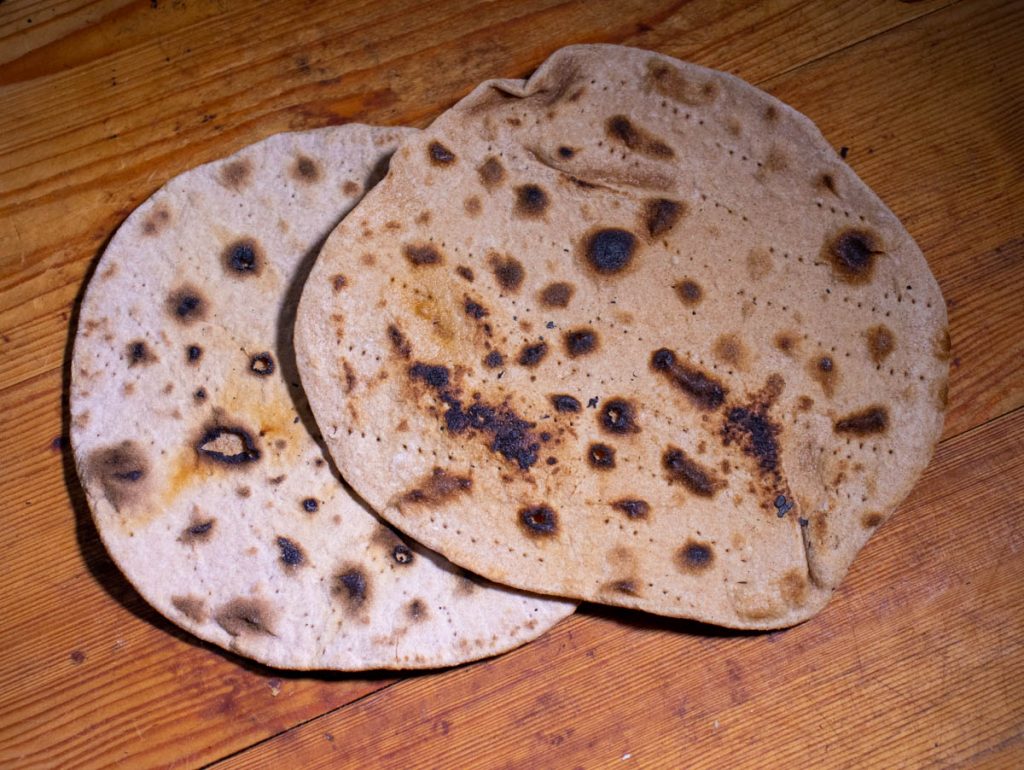
I was surprised that this was recipe that seemed most suited for a soft matzah to use at Passover. It has a deep matzah like taste, and a lovely chewy texture, while still being a little crispy on the outside.
Whole Wheat Flour: 171g (100%)
Water: 133g ( 78%)
If you want to add salt to this, or any of these recipes, add about 2.2% salt, which is a little less than 4g.
White Flour Matzah Cracker
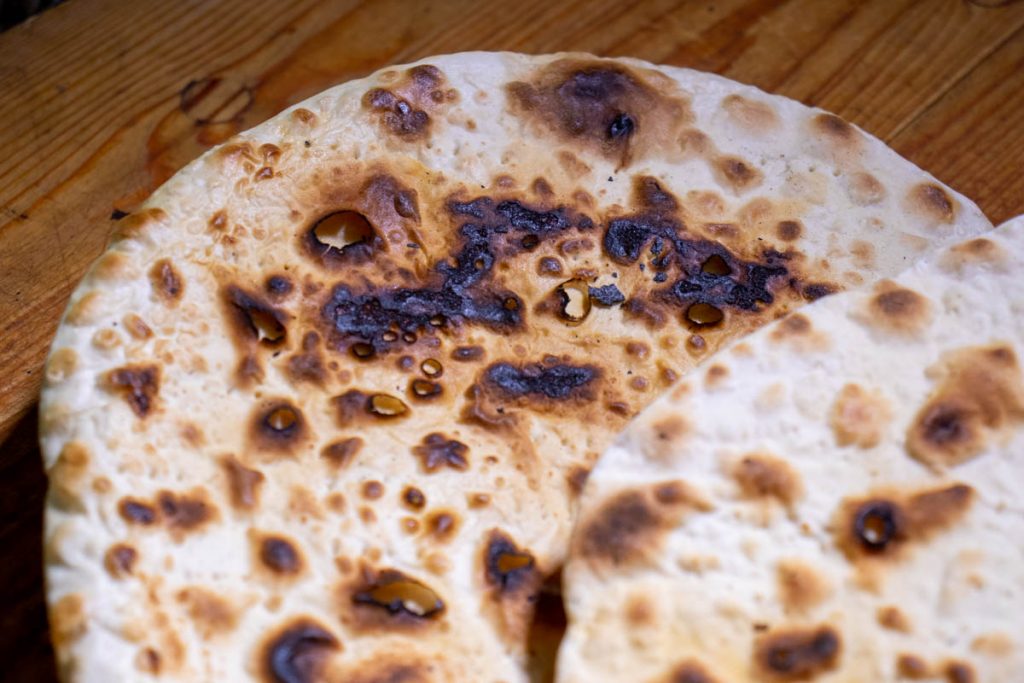
This is a dry, cracker-like matzah that’s reminiscent of the square boxed matzah (which, as I mentioned, I really like). In the possible Seder where I make my own matzah, I would probably serve both this and the 100% Whole Wheat to cover all of the matzah bases. This dough is kind of dry and crumbly at first, but it will come together with a little bit of kneading.
Bread Flour: 203g (100%)
Water: 101g (50%)
White and Whole Wheat with Salt
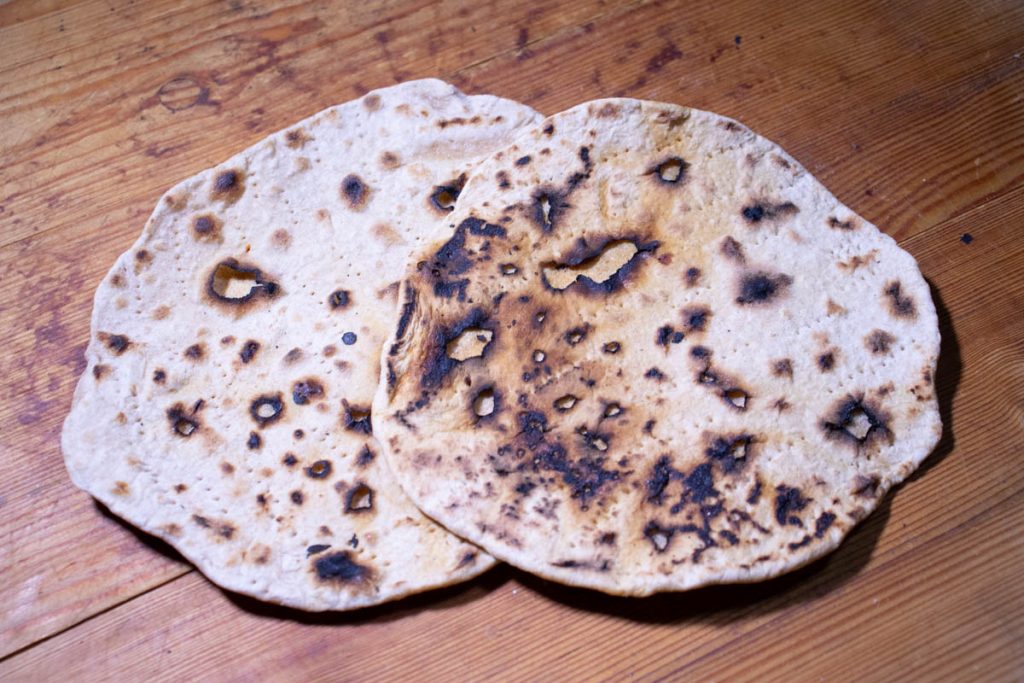
We eat matzah all year round. This version gets my vote for everyday matzah. It’s super simple to bake on any evening you want some bread and don’t want to spend more than 18 minutes getting it ready. The addition of salt makes a big difference in the flavor.
Bread Flour: 116g (66%)
Whole Wheat Flour: 60g (34%)
Salt: 4g (2.3%)
Water: 128g (73%)
If you want to try adding olive oil to this recipe, add around 9g and see how you like it.
Einkorn Matzah – The Real Thing
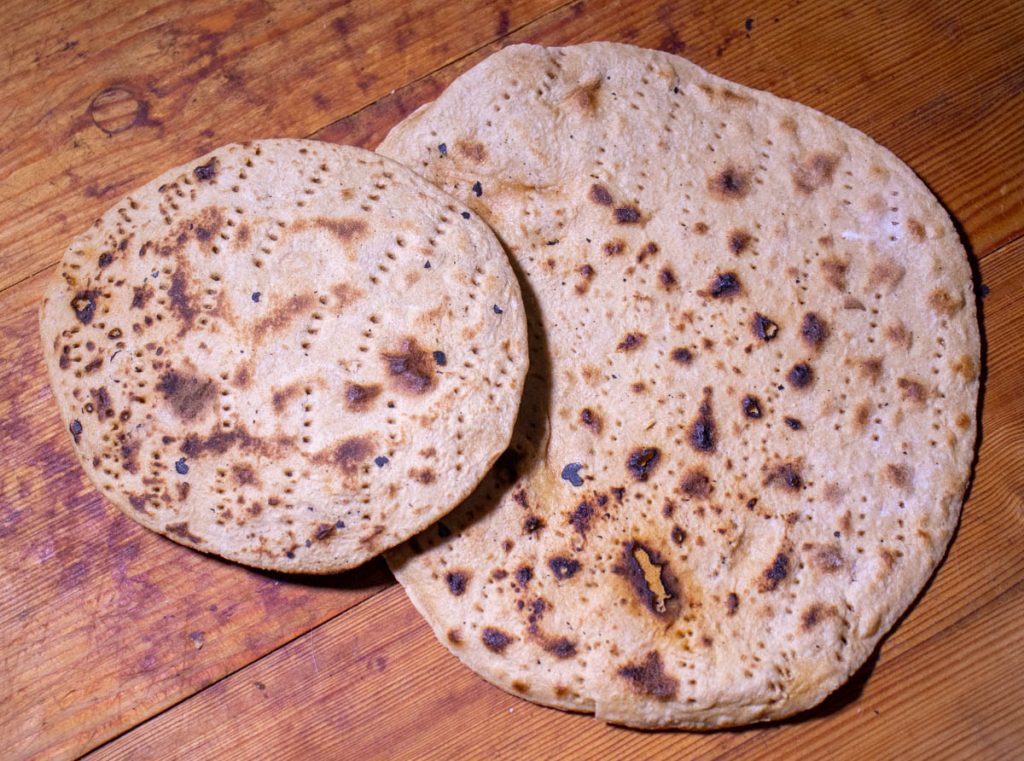
Einkorn and Emmer wheat were likely the varieties of wheat that the original matzah was baked from. As I have Einkorn on hand and can’t get Emmer at the moment, that’s what I used. Einkorn has a beautiful, soft nutty flavor that really comes through in these matzah. Usually Einkorn uses about 1/3 less water than white flour, but that doesn’t seem to be the case here.
Einkorn Wheat: 185g (100%)
Water: 120g (65%)
50% Rye Matzah
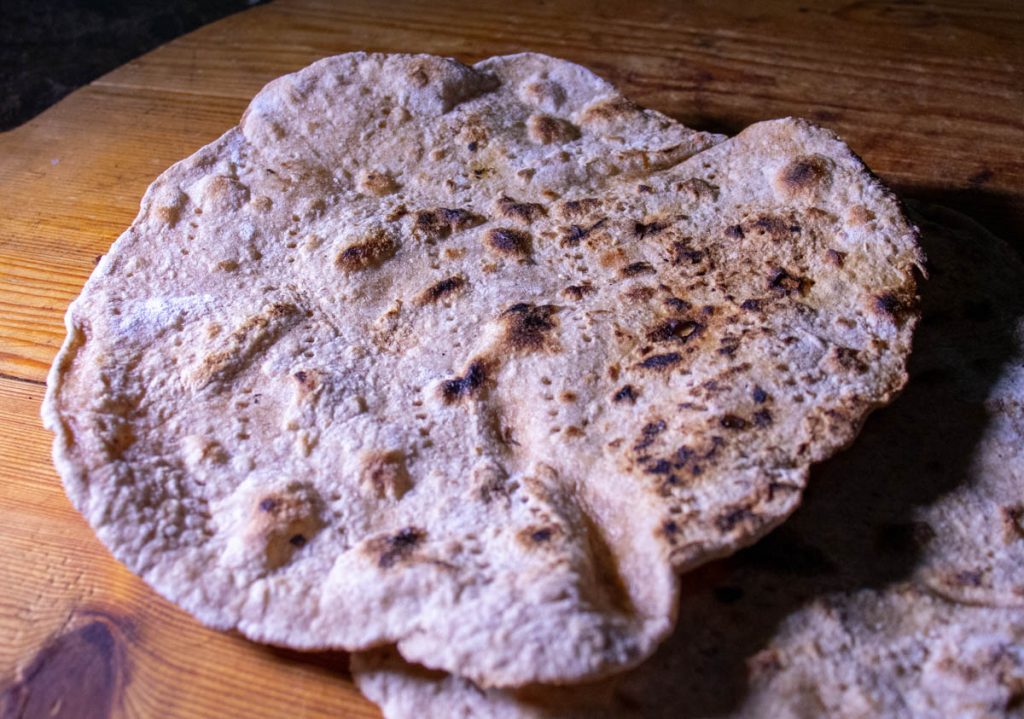
I tried this just on a lark and really liked it. The dough was a bit of a sticky pain to work with, but the resulting matzah had a really rich flavor, and, probably because the dough was sticky and harder to roll evenly, had a great mix of soft and crunchy bits.
Bread Flour: 86g (50%)
Dark Rye Flour: 86g (50%)
Salt: 4g (2.3%)
Water: 129g (75%)
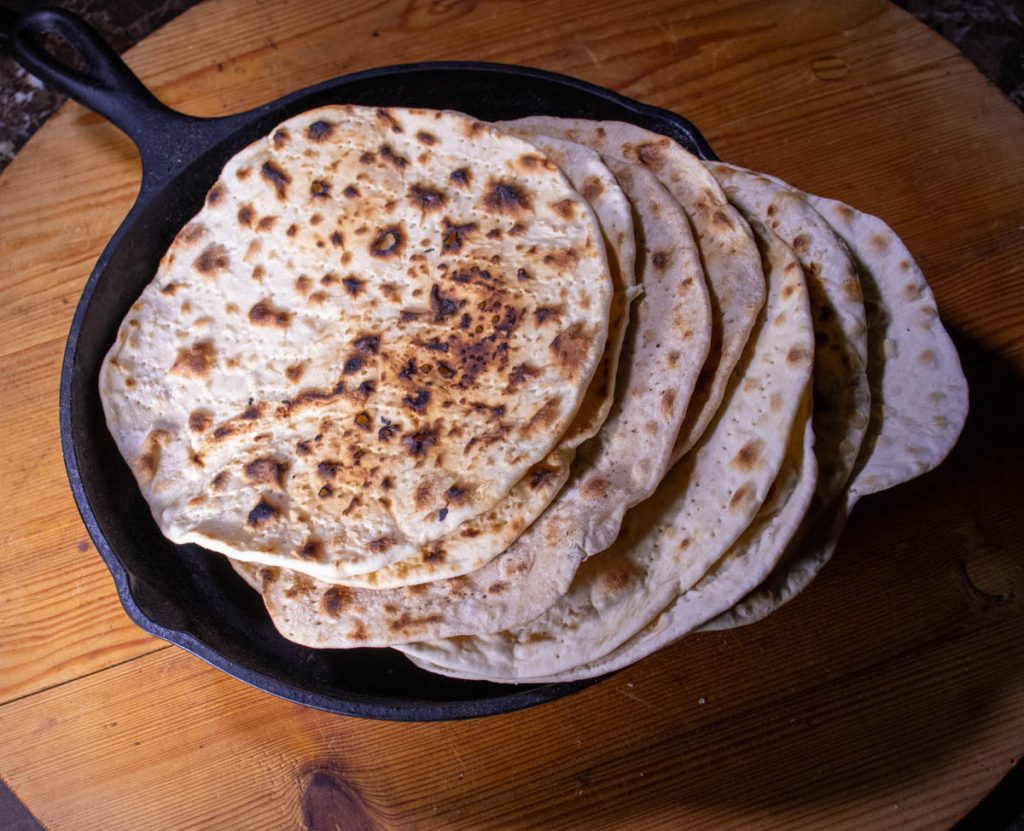
Adjustments
If you want to play around with these recipes to find the perfect matzah for YOU, these are some of the things you can play with. It’s a very forgiving dough, so even things that aren’t perfect are pretty good. (Not like a sourdough which, when it doesn’t work, really doesn’t work).
– Thickness: Try rolling the dough a little thicker or thinner.
– Hydration: Change the amount of water you use in the recipe.
– Flour mix: Try making matzah out of different kinds of flour, and mixing them in different proportions.
– Bake time and temp: Longer and slower as opposed to faster and hotter will give you different results. If you don’t care about the 18 minutes and just want a simple flatbread, you have lots of room to play here.
